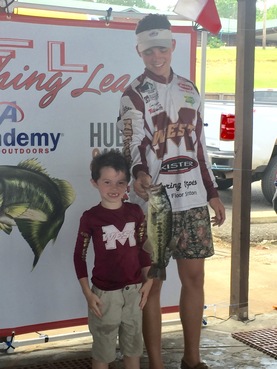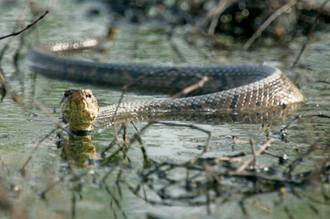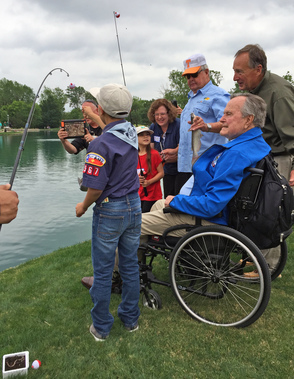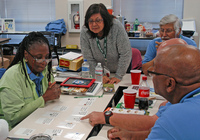|
In This Issue:
 The American Sportfishing
Association recently published a report entitled “Will
Millennials Sustain Sportfishing?” The report indicates there is a steady decrease
of angling participation across the nation for millennials over the past thirty
years.
Cameron Carter is a millennial. He is a junior at Magnolia West High
School, 4-H member, and founding member of his high school fishing club. He shares
his passion for fishing by helping his mother and father, who are TPWD
certified Angler Education Instructors, teach basic fishing skills to youth in
their community, setting the hook for a younger generation. Catch the
excitement in his story below, as he describes the anticipation and thrill he
experiences when fishing. With the help of our volunteer instructors, hopefully
we can change the trend for millennial anglers.
By now you may have noticed
how all of my projects in one way or another, go back to fishing. You might
wonder why this little sixteen-year-old boy could be so fascinated with it, to the
point that he can’t take his mind off of it long enough to write a coherent
paragraph, without mentioning it. It’s true, the very thought of fishing is
something that hardly escapes me, and because I wouldn’t want anyone to feel
left out, let me explain why: nothing compares to the chain of events that
comes after casting a line out to an open space, letting it hit the surface,
then bearing the focused silence that seems to overwhelm your body while it
sinks to the bottom. You pause for a few moments at the prospect that a fish
could be at the very spot you just casted, quite possibly looming over and
menacing as it inches forward to stare your bait directly in the face through
its callous eyes. You begin to slowly work your bait back to the boat, popping
it up sporadically, pausing off on and on from time-to-time in this charade of
duplicity. In attempt to be organic, your goal at this point is chiefly, to
create a deception that transmutes this artificial piece of plastic into some
type of forage. You pause again, eager that something is interested (give whatever
is engaged, the time of day), and if something hits, you willfully ignore the
natural impulse to feverishly bring it in. Once again you resist, wait and
anticipate for at least about a half of second; this is to make sure that the
tug you felt was in fact a fish that has interacted with your lure, not just a
branch or some other type of cover. In these instants of pent up adrenaline, it’s
at this point you methodically begin to reel all the slack out of your line,
lean into it, and set the hook. The
dream each time is to complete a clean
hook set, and this aspiration is met once you feel the weight of the fish,
and the fish fighting back. If you don’t, unfortunately that means you’ve not
fashioned a successful hook set, thus leading to the eventual loss of the fish.
Once you’ve completed a good hook set however, you have pretty much sealed the
deal for landing the fish, and already the excitement reels over your body at
the notion you done captured the fish already as my father would say it. Excitement grows to new levels as you begin
to make assumptions about what you’re working with by the bend of the rod and
the strength of the fish pulling against you…from there on it’s just
fighting it in avoidance to any possibility it may get wrapped around in any
cover or other hindrance that could cause you to break off. This fight is not a
strong man, brute force game, but rather an eloquent art form between two Brazilian
Jiu-Jitsu combatants in the octagon, with exceptional prowess and technical
skill. The angler must pull with just the right force and vigor, careful not to
pass the threshold of too intense and not intense enough. The idea is to keep sustained
pressure so the hook doesn’t come out, but to have enough restraint to avoid
the hook from bending. At any point where you are just winding it in as fast as
you can, you face a serious risk of breaking your line or this hook bending
out. Slowly but surely, you continue the process of working, fighting,
corralling, shepherding, ushering, attending, leading, and wrestling it back towards
the boat. At the point when it’s finally reached the boat, you anticipate the
fish coming out of the water to deftly secure the fish in a net, because if you
don’t, the floundering creature will undoubtedly flail vehemently, flopping
around and squirming for a way out…and the more he flops around
and contorts himself outside the water, the more likely he’ll be to shake the
hook in a last ditch effort for freedom. Forestalling the fish breaching the
surface, you are frantically, excitedly and fanatically (but very much manically),
calling for your partner to get the net in keenness to this foremost
significant and climactic moment. It is a progression of pressure filled final
moments followed by the temporary moments of excitement, tranquil peace, contentment
and gratification. It’s temporary but once you are comfortable you only look to
find that series of emotional events once more, looking for that rush yet
again. From there you are always chasing that fight because the satisfaction is
short lived; some may say you can get addicted to fishing, hook, line, and sinker.
Photo courtesy of Robin Carter, TPWD Volunteer
|
Back to Top
Kelly Simon, Urban
Wildlife Biologist for Central Texas
 I got the call early on a Friday. The voice on
the other end of the line quavered: “Please come help us deal with the snake in
the pond by our office! We don’t know if it is poisonous, but it is scary!”
Spring is a high activity period for local
snakes, both venomous and nonvenomous. The most commonly encountered snakes in
our area (Central Texas) are nonvenomous (Texas rat snake, Eastern hognose
snake, Texas brown snake), and the only venomous snake that commonly swims in
water (Cottonmouth) is actually pretty uncommon around the limestone of Travis
County. You can identify it because it’s entire body travels on top of the
water. Regardless, here was an opportunity to talk to lots of people about
snakes, snake habitat, and snake etiquette – so I gladly took it.
I brushed up on my water snake identification,
remembering back to a few of the aquatic snakes I encountered on Hill Country
hikes and paddling trips. In each case, the snakes were a part of the habitat –
a part of the ecosystem – and I saw them as the valuable, interesting, and
beautiful creatures they are.
When I got to the office complex, I was
surprised that most of the folks were actually happy to have seen the snake. They
were excited that their office complex, located right in the heart of Austin, was
hosting a complete Texas ecosystem and not just a few exotic koi fish here and
there. The serpentine visitor turned out to be the nonvenomous diamondback watersnake, who keeps the
ecosystem healthy by preventing ponds from becoming overstocked with small fish
and frogs.
While all of the native snakes in Texas are
beneficial and most are nonvenomous, it is still good to practice safe snake
etiquette while out wandering creeks, trails, and ponds. Check
out the TPWD website for some tips for
keeping these snakes from making unwanted contact with you.
So, what to do when you encounter a snake and
want to make that observation valuable? After checking your surroundings to
determine it’s safe, try to take a picture of it with your cell phone (from a
safe distance) and upload your sighting to iNaturalist.org, a platform for
people to provide valuable data on wildlife throughout Texas. It gives people
interested in nature a place to share observations, ask for identification
help, and talk with one another about nature. You can enter observations online
at http://www.inaturalist.org/ or through the iNaturalist app, available for
iPhone and Android devices.
|
Back to Top
Karen Marks, Aquatic Education Manager
 It has been a busy spring and summer, but
thankfully we have had some extra help at HQ from our summer intern, Emily
Kinney, a senior at Texas State University. Emily has been helping with events
in Central Texas, pitching in at the warehouse to wrangle equipment, and with
data entry of volunteer reports. We wish her luck as she continues to pursue
her education and career goals this fall.
In April, a kick-off event for the Vamos a Pescar Education Fund was held at the George H. W. Bush Library in
College Station. The education fund named in honor of President Bush, an avid
angler, was launched by the Recreational Boating and Fishing Foundation (RBFF). Grants were issued to partners in Texas and
Florida to engage Hispanic families in fishing and boating. After brief
presentations, families involved in the pilot project went fishing in the
presidential pond with support from the partners, TPWD, and Bass Pro Shops
staff. Even the former President caught a fish!
Also in April, Hutsell Elementary held their 10th anniversary fishing event, "Take
Me Fishing Hutsell" in Katy, TX. Nearly 300 people attended, including
alumni students and their families. What a beautiful day it was, especially
after the devastating floods that took place earlier that week. Many thanks to
all the volunteers and teachers who coordinated the event Robert Brashear, current
Principal Margie Blount, former Principal Keiko Davidson, Brenda Shaver, Michelle
Beer, Michael Scherer, Shelia and Willie Davis, Tim Gebauer, Michael Thomas,
Paul Walker, Richard Ogrin, Lynn Banks, Thor Larsen, Neil Stillman, Thomas
Fitzgerald, and many more!
Be sure to check our Instructor Resource web page for
several new teaching aids, lessons and other helpful PowerPoints and videos,
including:
- Regulation Scavenger Hunt
and Rummy card game
- Revised Basic Fly Fishing
Guide
- Revised Spanish version of
the Basic Guide for the Beginning Angler
- River Access and
Conservation Program PowerPoint
As summer comes to an end, so does our fiscal year.
Be sure to get all your summer fishing activity reports in by August 31st!
Remember for those multi-day events, be sure to document your volunteer service
hours by day. For information about reporting online, watch the helpful
video or print out the instructions, if
you need help with your User ID and password, just give one of our staff a call.
|
Back to Top
Michael Homer Jr.,
TPWD District Supervisor, Inland Fisheries - Abilene
For the average person, the thought of catching fish
involves casting a line with a rod-and-reel and reeling it in hoping to land a trophy
fish. Yet, for fisheries biologists, rod-and-reel sampling is not always
practical to monitor fish populations. Numerous methods are used by TPWD Inland
Fisheries Division biologists to monitor fish populations in the state.
Fish
surveys are conducted for research, monitoring population trends, and to
evaluate management strategies. The survey data is used to make sound
management decisions such as regulation changes, gear restrictions, habitat
enhancements, and stocking requests. Once management questions and data needs have
been identified, a sampling strategy that is either “passive” or “active” is
developed. Passive gears are set for a period of time and then retrieved.
Examples include gill nets, trap nets, and hoop nets. Active gears are operator
controlled while the fish are being captured. Examples include electrofishing,
seining, and rod-and-reel.
Gill nets, usually used during the spring, are most commonly
used to monitor catfishes, temperate basses (e.g., striped bass, white bass,
and hybrids), and alligator gar. Gill nets are elongated nets made of
monofilament that resemble a chain link fence, it has a float line on top and is
weighted on the bottom so that it will sit on the bottom of the lake floor.
Typically, gill nets are set overnight and retrieved the following day.
Trap nets (also
called frame net) are mostly used to monitor the crappie population during the fall,
and are made of metal or fiberglass frames that form a netted box with a long
series of hoops called a “codend.” At the front of the frame, a long line of
netting called the “leader” is pulled out. The leader resembles a chain link
fence with very small holes that most fish will not be able to swim through. Trap
nets are set perpendicular to the shoreline with the leader on the edge of the
shoreline and the codend in deeper water. Trap nets are effective at capturing
crappie and other fish that are actively moving along the lake bottom. Fish will follow the leader until they go
inside the frame and get trapped in the codend. The netting on the internal
frame is arranged so the fish can swim in, but cannot swim back out. Like gill
nets, trap nets are set overnight and retrieved the following day.
Hoop nets are a non-traditional sampling gear used during
late spring through early fall, and are becoming increasingly popular for
sampling channel catfish. Hoop nets are comprised of seven fiberglass rings
that taper towards the codend to form the internal frame, and the exterior is
covered with bar mesh. Internally, a bait bag filled with an attractant is tied
in the codend. The front of the hoop net is open, fish swim inside and get
trapped by a tapering throat. Hoop nets can be tied
together in a three-net tandem series, and they are most effective when baited
with smelly baits, and are set for 1-3 days.
Since the 1940s, electrofishing has been an important method
for monitoring fish populations worldwide, and is effective for sampling a wide
variety of species. Electrofishing is the preferred sampling method used by
TPWD and is used to sample many popular sport fish such as largemouth bass,
blue catfish, flathead catfish, and prey species such as sunfish, minnows,
shad, and silversides. Backpack-mounted electrofishing is used for small stream
sampling, and boat-mounted
electrofishing is used on large water bodies. Anodes are lowered into the water
to stun fish. Because the fishes’ bodies
carry an electrical charge, every time the generator sends an electrical pulse
into the water, the fishes’ muscles contract and swim towards the anodes. As
fish surface, they are collected in nets.
Once data is collected, the fish are returned without injury. Interestingly,
electrical pulse settings can be adjusted to target certain species. For
example, low-frequency is used to sample flathead and blue catfish, high
frequency is used to sample largemouth bass, sunfishes, shad, and many other
species. Most electrofishing for largemouth bass and prey species is conducted
during evenings in the fall.
Although
a few fish may be sacrificed to collect age and growth information, TPWD
fisheries biologists employ the most feasible methods to collect data and
return fish back to the water safely. Ultimately, the data collected will
inform the biologists about the state of sport fish and prey populations so
needs can be identified and management plans developed that will make fishing
better in Texas. If anyone is interested in learning more about fisheries
sampling methods or statuses of fisheries resources, they should contact their
local TPWD
Inland Fisheries Division office.
Photo credit: Clint Robertson, TPWD Inland Fisheries
Back to Top
 Welcome New Instructors and congratulations to our Area Chiefs who earned their Bronze, Silver, Gold and Platinum awards!
Both Karen and Keira missed the annual Area Chief
training meeting this year, but thankfully Audra, Caleb, and Greg were able to
step right in and conduct the meeting without a hitch.
The meeting was held on April 1st- 2nd in
Austin. Twenty-three people attended, including 10 new Area Chiefs! Activities included a Riparian Field Study led by
Johnnie Smith, TPWD Conservation Education Manager, round table discussions, presentations about Invasive Species by Monica
McGarrity and Alligator Gar by Clint Robertson, both from our Inland Fisheries
Division. Our friends from Fishing’s Future sponsored the lunch on Saturday. When
Karen got back to town, she was delighted to hear about the great meeting from
our volunteers:
On the weekend of April 1st, 2016 I had
the pleasure of attending my first Area Chief meeting in Austin. I could not
help but jump at this great opportunity to grow in the fishing community listen
to ideas, and soon place it into practice. Teaching and sharing knowledge to anglers
ranging from kids to adults in spincast and fly fishing, beginners to experts
is great because it makes them aware of important information whether it is new
or they’ve heard it a hundred times. It helps them grow, and allows them to
enjoy the outdoors even more.
My favorite part was to meet and network
with all the other Area Chiefs: some retired, some fishing and teaching, and
the ones who are new. I love to connect with those that have the same interests
as me, enjoy the outdoors, to see those who are supportive of the Texas Parks
and Wildlife programs. Being around this amazing group makes me smile. Being
new to the Area Chief program, it was nice to hear new ways of teaching both
adults and younger generations from others. It gave me many ideas and I can’t
wait to put them into action! I really appreciated professionals coming in and
speaking about invasive species and Alligator gar.
We all need to be aware of what is out
there, how to identify species and correct information, but most importantly the
best ways to teach and share that knowledge. I’m looking forward to teaching as
an Area Chief and working with other volunteers to help TPWD in any way or
form, share and pass down knowledge.
Life is Truly Better Outside!
Kim Penick, TPWD Area Chief, Plano,
TX
**********************************************
Thank you so much for
conducting such a wonderful 2016 TPWD Area Chief Conference last weekend! I
know y’all spend lots of time planning these events out and we really
appreciate it! This year was different since Karen had to leave at the last
minute for a family emergency and Keira could not attend due to having the flu,
but Karen's Area Specialists and Assistant did a great job taking over!
I especially liked the
Fish Fry on Friday evening and the round robin on Saturday where four different
scenarios were presented and we had to list answers and ideas on a poster
board. A bonus to this was where we could judge 1st, 2nd, & 3rd in
importance later. I am especially looking forward to an email sent to all of us
summarizing our answers and ideas. Exercises like this is why it's important
for Area Chiefs to attend every year, plus to be re-charged for the coming year!
Thanks again for leading
this important conference & all you do for us,
Tim Gebauer, TPWD Area
Chief, Katy, TX
Photo credit: Audra Wert, TPWD
|
Back to Top
Back to Top
Back to Top

|